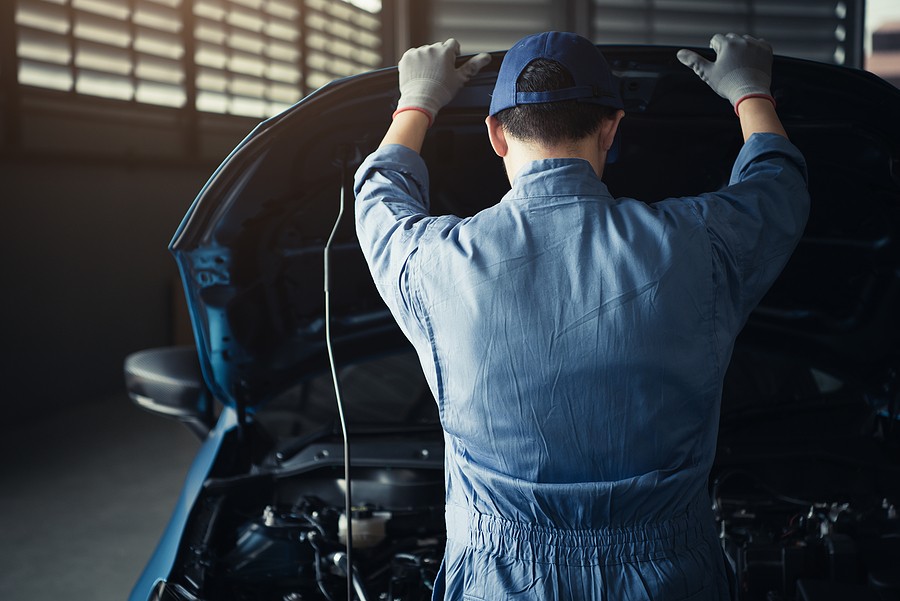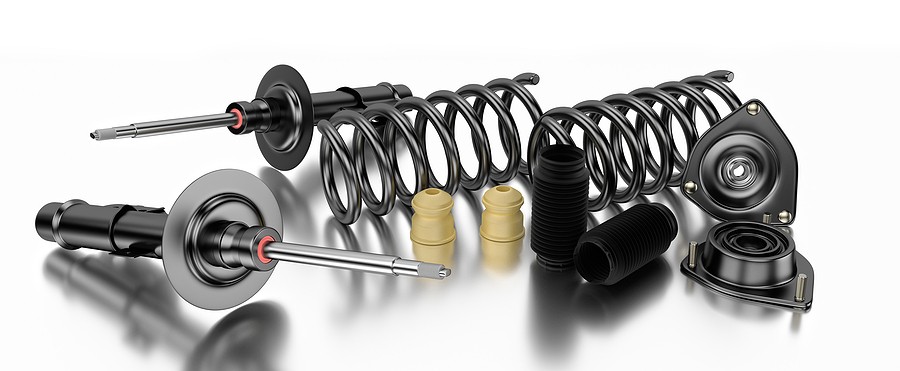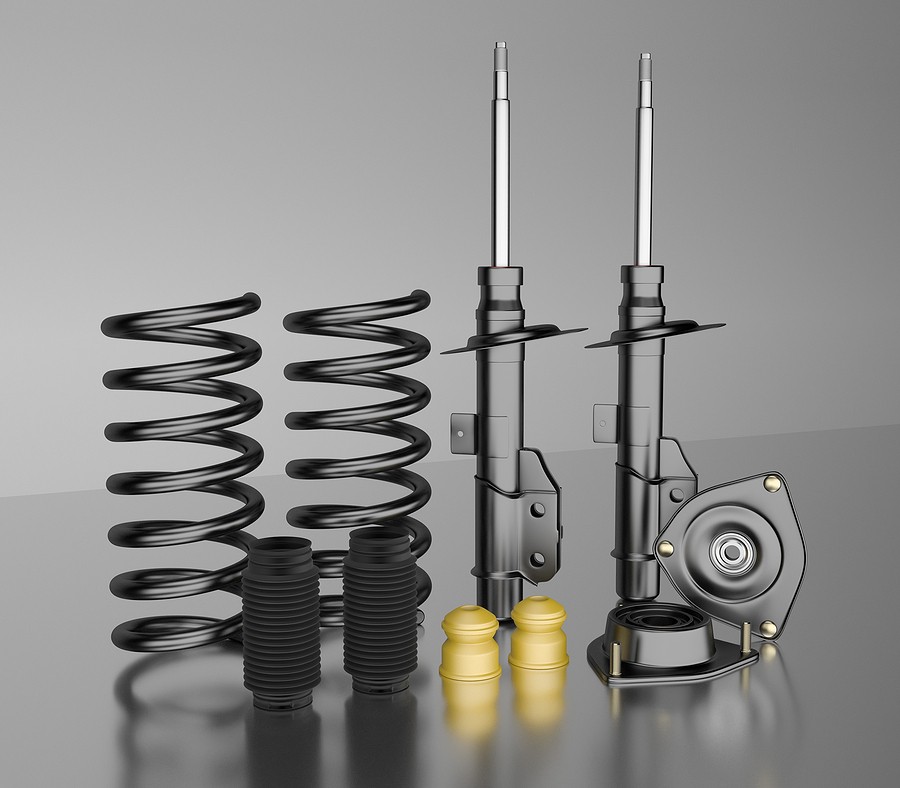Shocks and struts are both components of the suspension system in your car, and are commonly made up of spring and shock absorber. These car components help reduce jolts and improve the steering and alignment of your car. Like most car parts they are subject to wear and tear so you should know when to replace shocks and struts to keep your vehicle running safely and smoothly. If you have shocks or struts, or both, you should replace them every 50,000 miles at the very least.
Driving on faulty shocks or struts is not only inconvenient for the driver. It's also potentially hazardous. Shocks and/or struts that are damaged can cause a loss of control when driving through turns, reduced braking capability, and instability when changing acceleration. Simply bouncing your car and watching the give can reveal whether or not your shocks and struts are in good working order. If it doesn't bounce back, it's likely time to replace the shocks and struts.
Besides what was already mentioned, there are other things you should know about when to replace shocks and struts and we will learn about it and more in this article.

Is a strut and a shock the same thing?
Before we discuss when to replace shocks and struts let us first look into this commonly asked question of whether or not strut and shock are the same?
You might not give your shocks and struts much thought. But it is actually them you have to be thankful you have each time you hit a pothole or a bump in the road! No matter how level and smooth a road is, no road surface is actually smooth, so you need those shocks and struts if you want to keep control and enjoy a smooth ride.
While the phrases “shocks” and “struts” are frequently interchanged, they are two distinct components that serve different purposes. A strut cannot be used to replace a shock, and a shock cannot replace a strut.
Shock absorbers are hydraulic components that help to reduce the amount of movement caused by the springs on the vehicle. These springs help to dampen the jolts caused by uneven or broken roadways. Shocks assist you to keep better control over your car by reducing the impact of bumpy roads and rocky terrain, resulting in a smoother, more comfortable driving experience.
On the other hand, struts are structural components of the steering and suspension systems of some cars.
Not all vehicles will have struts
While a lot of vehicles have shocks on one axle and struts on the other, one thing you should know is that not all vehicles actually have struts. You may have a vehicle that uses separate springs and shocks instead of struts.
To know if you have struts then take a look under your car. You should find shocks usually installed vertically behind the tires if your car has them. Shocks are frequently designed to resemble a spring or a pump. Struts, on the other hand, are normally positioned horizontally and seem as a wheel extension. You can look at both the front and rear wheels to see if you have both shocks and struts.
Even though most struts have a spring and pump mechanism, not all struts have springs. If you're not sure whether your vehicle has struts or shocks, you may always check with your local technician.

How do I know when my shocks need to be replaced?
Shocks and struts can wear out over time, especially if you do a lot of off-roading or drive on bumpy roads. After 50,000 miles or according to your car manufacturer's maintenance schedule, you should have your shocks and struts inspected. If you're not sure when they were last inspected, here are some symptoms to look for to see if it's time to get them looked at:
Here are some signs of worn shocks and struts to know when to replace shocks and struts:
- Mileage. Many cars require shock and strut replacements around fifty thousand miles, depending on the vehicle. Maintaining your car's shocks and struts can help you avoid long-term damage, so it's always better to be proactive and have your suspension checked every 50,000 miles rather than waiting for something to go wrong. After 50,000 miles or according to your vehicle's maintenance schedule, have your shocks and struts evaluated.
- Is your automobile bouncing or bottoming out when driving on bumpy roads? It's easy to detect whether your shocks and struts need to be replaced if your ride is bumpy or unsteady. To begin, ensure that your tires are not over-inflated. If your tire pressure is correct, your shocks and/or struts are most likely the source of the problem!
- In turns, the vehicle “tips” to one side. Your car leans or “tips” to the outside of the turn and feels unsteady when taking a tight turn or an off-ramp.
- During forceful braking, the front end dips more than expected. You might not realize it until you have to slam on the brakes. When struts are worn or damaged, the vehicle may have braking instability.
- During acceleration, squat your back end. During heavy acceleration, you'll observe that the front end of your vehicle rises while the rear “squats.”
- Excessive bouncing of the tires. You can feel a tire (or tires) reacting or “bouncing” after striking a bump. A clunking sound may also be heard.
- Problems with Steering. Another indicator of old shocks or struts is a lack of steering response. It's possible that the steering wheel is stuck or difficult to spin, or that it's making unusual noises.
- Although unusual wear patterns on your tires are not always a clear indicator, it may be time to replace your shocks and struts.
- Fluid is leaking outside coming from shocks or struts. This is an indication that the seals have failed and that vital internal fluids are leaking.
- Struts that are visibly damaged. While most strut damage is felt rather than seen, you may find struts or shocks that are obviously damaged or dented. When an automobile has to be replaced, fluid leaks in the area are also a possibility.
While there are several apparent symptoms of shock and strut problems, others are more difficult to spot. Uneven tread wear, for example, can lead you to believe there's a problem with your shocks or struts, but the same symptoms can also indicate wheel alignment issues, inflation concerns, or a variety of other issues. That's why, before “self-diagnosing” your car, you should get professional advice. Replacing outdated or worn out shocks and struts isn't just good for your car; it can also protect your tire investment by eliminating excessive wear and extending the life of your tires.
What does it sound like when you need new struts?
The sound of a bad strut is frequently described as hollow clunking or pounding. The noise is most noticeable when the vehicle is traveling over bumps in the road. A faulty strut mount sound—an audible clunking or squeaking when rotating the steering wheel—is also possible.

Do I need to replace both shocks and struts?
Shocks and struts should be replaced together whenever possible. The left and right shocks/struts, unlike some other steering components and suspension components, tend to wear out at the same pace. If the left shock or strut is damaged, it's likely that the right one will need to be replaced as well. The wear levels of the front and rear tires can fluctuate based on the terrain and how the vehicle is used. When front shocks or struts need to be replaced, they usually need to be replaced as well. Your owner's manual or your dealer may provide you with the proper maintenance schedule for changing your shocks and struts. Shocks and struts should be replaced every 50,000 to 100,000 miles, according to industry standards.
Do you have to replace all 4 shocks at once?
Yes. It is recommended that the shocks and struts be replaced in pairs (both from the front and the rear axles), and it's even better if all four wheels are replaced together. This will help maintain consistent handling as well as response or reaction on both sides of your vehicle.
It’s also best to get an alignment once any suspension work is completed. Any alterations to your suspension may affect the wheel alignment of your car. Even slight adjustments to wheel alignment can have costly effects down the road (accelerated tire wear, more suspension problems, difficult handling).
How long do shocks and struts usually last?
Shocks and struts can be made to last 5-10 years or 50,000-100,000 miles on average given it is under ideal driving conditions. Many factors can affect the longevity of these components and as to when to replace shocks and struts and that include: manufacturer, bad roads, excessive loads, towing, hard braking and aggressive driving. It is advised to start inspecting these parts frequently after roughly 40,000 miles or if the car starts to bounce, droop, have increased braking distance or other suspension problems.
Shocks and struts can both cause dangerous conditions like bouncing and poor braking, which can lead to vehicle accidents. So have them inspected if you find something unusual. Front struts are crucial when it comes to your steering system, so if they are left with issues and are unattended the steering could be catastrophically affected. If these parts of your vehicle completely collapse, the car will most certainly be undriveable.

What happens if you don't replace struts?
So, what happens if you don't replace your struts when they break? Riding on worn-out struts or automotive shocks has two drawbacks. First of all, worn struts cause longer stopping times and/or distances because the vehicle weight shifts (often unexpectedly) while braking. This will certainly cause you to lose control of your vehicle.
Secondly, driving with faulty struts causes tire wear as well as wear on other suspension components such as the springs.
It’s very important to know when to replace shocks and struts and to act on your findings. Have the automotive shocks or car struts carefully evaluated if you sense anything isn't quite right with the way your vehicle behaves. When they go bad, the consequences can be deadly.
For better stopping performance, vehicle stability, and driver control, it may be time to replace them. When you replace your shocks and struts when they're worn out, you'll avoid damage to other car components like the tires and suspension, and you'll be safer on the road!
Today's vehicles come equipped with a variety of safety features that aid improve handling and stability while also reducing the risk of an accident. Anti-lock brakes, stability control, traction control, automated braking, and other safety measures collaborate to keep you safe. In an emergency, if your shocks and struts are damaged, they may not respond effectively to these systems' electronic impulses.

How much do new struts cost?
The cost of replacing struts varies greatly based on the brand of struts used (typically), the type and model of your vehicle, and the location where the strut repair is performed.
You will have to set aside between $450 and $900 on the average if you intend to replace a pair of struts. The individual strut assemblies will cost about $150 to $300, so expenses for the parts alone will cost you between $300 and $600. For the pair, the cost for labor will require you to pay between $150 and $300.
If you wish to have professional help, a car dealership will do your strut repair but it can cost you a whole lot of money. You can expect to be paying at least $1,000 just for a normal front strut replacement. You will need to shop around for this type of service. Go to a reputable independent mechanic that can give you the best deal.
As mentioned a wheel alignment will also be needed after having new struts installed, and that will cost an additional $40 to $80. A four-wheel alignment, on the other hand, will cost an additional $80 to $160 if all of your vehicle’s four struts are rebuilt.



